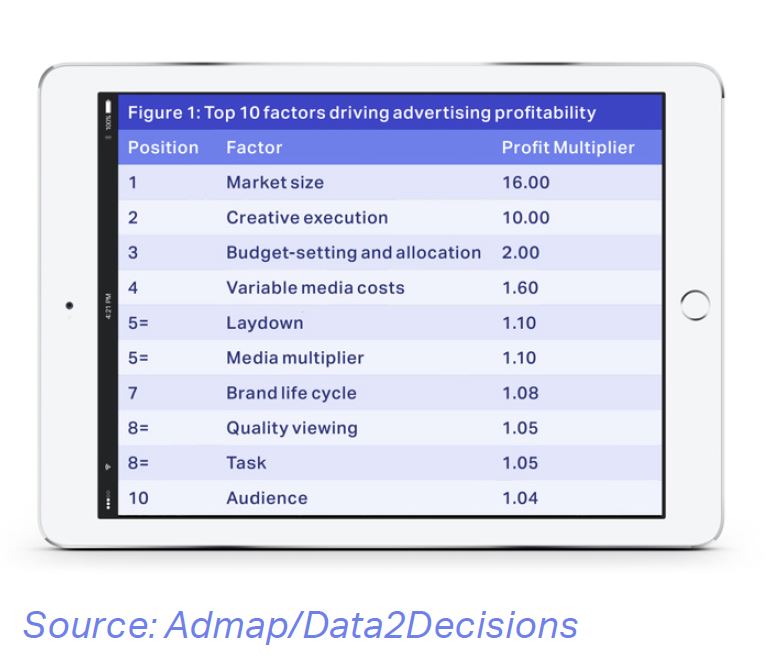Now that content has tapped into the power of ideas, proper investment needs to support it to ensure it can be consistent over time, says Nick Kendall, Founding Partner of Broken, Electric Glue and The Garage Soho.
I have judged the WARC Awards’ Effective Content Strategy category twice now. The first year, I must confess, I was disappointed by the general quality of entries. There were some great prize winners in 2017: Knorr’s Love at First Taste was a big enough idea to last and last. The MS bicycle idea left an indelible image in my mind. KFC’s cheesy lines were… well, gloriously cheesy.
I can still remember these cases and still recommend them as ‘good reads’. They were exceptional but they were also, I fear, exceptions.
So at WARC’s celebratory event reviewing the learnings I was, I am afraid, a bit of a humbug. Using the famous chart (below) as my only slide, I ranted and reminded everyone of the proven importance of creativity in securing an ROI.
I suggested that, all too often, it seems papers are obsessed by ‘what the pipes can do’ and not The Idea itself. Maybe this is not surprising as it is an early discipline and we therefore focus more on the ‘content’ part of our ‘content ideas’. Indeed, the definition of a ‘content idea’ for these awards is the one offered by the Content Marketing Association itself: “Content is about sustained attention, gaining your audience’s trust by drawing them into your brand’s community for a desirable amount of time.”
Whether that makes things clearer for you I will leave you to decide. What is clear for me is that it tries to define the ‘content’ side of ‘content ideas’. Maybe what matters more is the definition of an idea.
The definition of how and where an idea appears will keep on changing, but the definition of an idea (and the power of greatness to be the flywheel of success) will not. “An idea captures the audience’s interest, influences their emotional response, and inspires them to action.”
In this year’s awards, I am pleased to say, I saw lots of great ideas. My favourite (other than Coke’s Grand Prix) was Slow Trends by Lebanese brand Connect. It got me thinking again. Slow Trends had no budget. The idea itself created its own audience – proof again of the capacity of ideas to power their own media.
But what would have happened if the power of media (and a budget) had been applied to the idea? One of the joys of content is its ability to achieve good things on small budgets. Most of the papers in 2018 seemed to arrive at their current content approach out of crisis: ‘budgets were low’, ‘competitors dwarfed us’, ‘times were desperate’, ‘we needed a different approach’, etc.
A shift in perspective
It is noticeable that, of the 13 winners, nine enjoyed a budget of less than $500k. Two thirds of shortlisted papers claimed their budget was $500k or less, and most often much less. Given the quality of many of the ideas in this year’s awards, I wonder if the time is right for a shift in perspective? Maybe content should stop being the poor cousin and grow up to become the central player in a brand repertoire. Many of the ideas here are capable of that.The Coke Grand Prix is an example of one idea spawning many, STC’s Unveil Saudi is a campaign that can become a long-term positioning, while EGBank’s The Chronicles of Oufa could run and run. If only these ideas were approached as more than a ‘one off’, given more central importance and funded with more budget! The problem, I would guess, is one of old practices behind new forms and, in this case, the old practice is setting budgets and fixing them at the start of a year.
As a result, even though these cases prove themselves to be effective at small budget levels, there seems to be no ‘new best practice’ of putting more money behind the success in order to take them to the next level.
Maybe more organisations need to develop ‘dynamic’ or ‘performance-related’ budgeting practices; with budgets being allocated as an idea takes hold. In the absence of this method, I can only hope that many of these ideas will be supported again next year, and built upon, rather than discarded as more digital landfill – the equivalent of single-use plastics!
Imagine what Nippon’s, or Maxis’ campaigns would look like with more investment. Certainly Live Love Laugh’s Ask Again is a deep thought that will take time – and should take time – to become a cultural norm. Kitten Kollege could be the Open University of the ‘Caternet’ if given long-term budget support. Dear Younger Me could become a compelling series (a kind of Desert Island Discs) if given time to grow. Consistency – lest we forget at our peril – is the baseline for brands. True broadcast fame – lest we also forget – is the life blood of success.
Scaling, and scaling hard behind proven success, is the new business practice. Now content is growing up and finding ‘the power of ideas’. So let’s make sure we have ‘the power of media’ to drive them.
This article appeared originally in WARC’s Effective Content Strategy Report.


